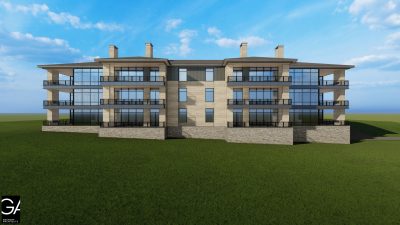Armonk Residents Worried Condo Project Would Draw Down Wells

Several residents demanded North Castle officials and representatives of the Summit Club golf residential community last week take steps to protect their wells as the developer searches for an alternate water supply for the project’s residential component.
A special live-streamed Town Board meeting last Wednesday evening to discuss potential test drilling on a town-owned parcel on Willow Pond Lane came two nights after the applicant appeared before the Planning Board for the first time for site plan review of the proposed 73 luxury condominium units.
Irrigation for the redesigned golf course, which is scheduled to open in the spring, is supplied by on-site wells. The entire property is 156 acres.
Willow Pond Lane and Blair Road residents near the proposed drilling site said they wanted to guard against having the quantity and the quality of their well water diminished. They urged the developer to post a bond before drilling begins and for the town to hire an independent hydrogeologist to represent the residents’ interests.
The Summit Club, which is part of the town’s Water District #2, needs to find a water source of at least 100 gallons per minute to sustain the 73 condos. However, it was unable to reach that threshold at sites on portions of Windmill Farm, located across Route 22 from the Summit Club, which was formerly referred to as Brynwood.
Will Minkin, a 51-year Willow Pond Lane resident, said routine mitigation in the event of excessive drawdown, such as the installation of pumps or drilling a deeper well at the developer’s expense or getting connected to a municipal water supply, is inadequate.
“How am I going to be indemnified if my gallons per minute goes down or if the pond turns into a mosquito-infested swamp, if the value of my home goes down because of these factors?” Minkin said.
Blair Road resident Eric Goodison said the posting of a bond by the applicant should be done before any work begins to protect the homeowners. Unlike Windmill Farm, whose costs to repay a $10 million water infrastructure improvement project bond several years ago would be proportionately reduced with the inclusion of the project into the district, there is no benefit for the property owners on Willow Pond Lane and neighboring streets, he said.
“It shouldn’t be difficult to post (a bond),” Goodison said. “If it’s that important for that project, then they can look out for this neighborhood.”
Willow Pond Lane residents Randi and Robert Wolchok, in a letter to town officials, supported the argument that any reduction in the quality and quantity of water for residents near the drilling site should be the sole responsibility of the Summit Club.
The applicant had drilled on the southern and northern portions of Windmill Farm. However, both sites fell short of the required 100 gallons per minute set by the town, including a disappointing three to 20 gallons per minute at the northern location, said Thomas Cusack, a hydrogeologist for the Summit Club.
Cusack said while the town is requiring 100 gallons per minute, which would equal 144,000 gallons of water a day, to make certain there is ample supply, the condos need only 34,000 gallons a day.
While it was hoped that enough water would be found at Windmill, Cusack said he is more optimistic that the Willow Pond parcel will produce high-yielding wells because it has two critical hydrogeological features – a fault line and fractured trace patterns.
“Wells built on faults and fractured trace patterns, particularly when they intersect, which is what is exhibited here on these study parcels, where the faults and fractures intersect, it means it increases yield capacity or the likelihood of drilling a high-yielding well by 80 percent, which is actually very dramatic,” he said.
Another advantage of Willow Pond Lane is the Summit Club wouldn’t need a permit from the state for disturbance to a state-regulated wetland, which takes at least eight months to obtain, Cusack said. The parcel, though, is in a town wetland.
North Castle’s consulting hydrogeologist William Canavan said drill tests don’t necessarily reduce a nearby well’s water depth, and if a 200- or 300-foot well loses five or 10 feet, that isn’t a significant reduction. If the drawdown is closer to 100 feet, it would never be approved by the regulatory authorities, he said.
Last week Town Board members said they weren’t prepared to make a recommendation to allow for tests at the site. Councilwoman Barbara DiGiacinto said she needed more time and information to make a decision.
Supervisor Michael Schiliro said that the Town Board in its role as North Castle’s water commissioners represent all residents, including those on Willow Pond Lane, and would not permit an applicant to jeopardize a neighborhood’s water supply. It was a sentiment echoed by Councilman Jose Berra.
“We all take very seriously our obligation to the residents, all the residents, but also particularly residents that can be impacted,” Berra said.
The Summit Club is scheduled to return next month to the Planning Board, possibly in a joint session with the Architectural Review Board.

Martin has more than 30 years experience covering local news in Westchester and Putnam counties, including a frequent focus on zoning and planning issues. He has been editor-in-chief of The Examiner since its inception in 2007. Read more from Martin’s editor-author bio here. Read Martin’s archived work here: https://www.theexaminernews.com/author/martin-wilbur2007/
